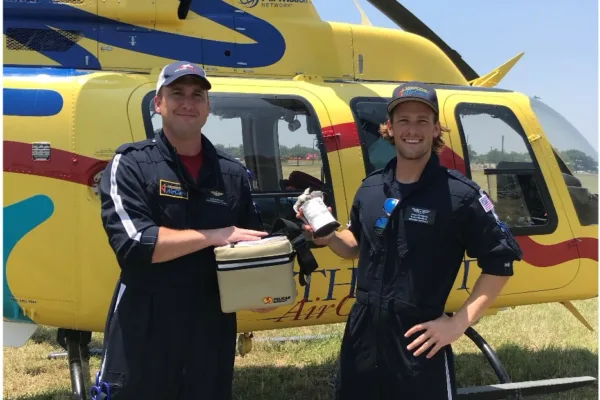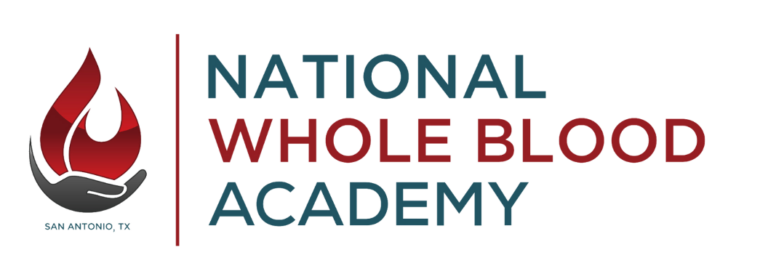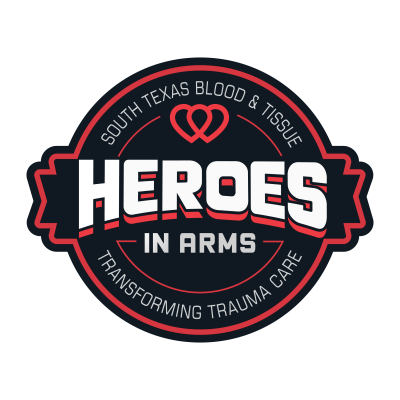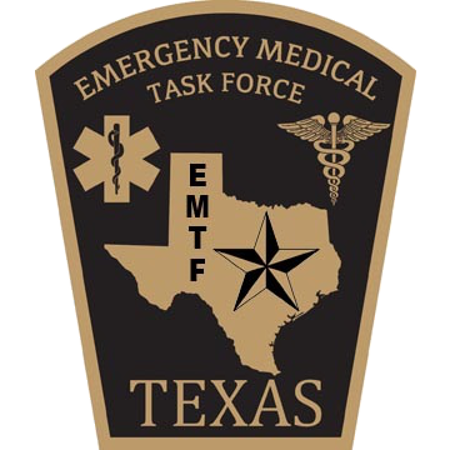Regional Whole Blood Program

The STRAC Regional Whole Blood Program is a consortium of multi-disciplinary, multi-institutional members. Members include South Texas Blood and Tissue Center; Regional Trauma Centers, including University Health and Brooke Army Medical Center; and Regional EMS agencies, both ground and air. This program is the national leader in pre-hospital whole blood with the mission to reduce pre-hospital death due to hemorrhage. This program has extended damage control resuscitation capabilities to all levels of care within the STRAC region while keeping costs down, establishing a robust blood donor pool, and keeping blood wastage rates due to expiration below the national average.
If you are interested in joining the STRAC Whole Blood program, please Contact Us.

You Know Why... Now Learn How
The STRAC Regional Whole Blood Consortium presents a novel model for the development of a Low-Titer O-Positive Whole Blood (LTOWB) program. This program provides participants an example of how to augment remote damage control resuscitation strategies; and how to integrate and collaborate with multi-disciplinary stakeholder teams, within a trauma system, to optimize efficiency, performance, and safety of a LTOWB program.
The National Whole Blood Academy is presented in beautiful San Antonio, Texas. This two-day event encompasses didactic presentations from LTOWB subject matter experts discussing real-world wins, challenges, and obstacles experienced during the development and implementation of this program.
Ideally, anyone and everyone involved in providing pre-hospital whole blood to patients (Paramedics, Department Chiefs, Training Officers, Blood Bankers, Trauma Surgeons) attend together to promote collaboration and system building.
July 14, 2025
Committees and Workgroups
Regional Whole Blood Committee
Whole Blood In The News
Participating Organizations
Publications
| Title | Summary | Categories | Creation Date | Link | hf:doc_categories |
|---|---|---|---|---|---|
| Transfusion-related cost comparison of trauma patients receiving whole blood versus component therapy. | The journal of trauma and acute care surgery, 95(1), 62–68. Authors: Ciaraglia, A., Myers, J. C., Braverman, … | Publication | February 11, 2023 | publication | |
| Use of Cold-Stored Whole Blood is Associated With Improved Mortality in Hemostatic Resuscitation of Major Bleeding: A Multicenter Study. | Annals of surgery, 276(4), 579–588. Authors: Hazelton, J. P., Ssentongo, A. E., Oh, J. S., Ssentongo, P., … | Publication | October 1, 2022 | publication | |
| Impact of Incorporating Whole Blood into Hemorrhagic Shock Resuscitation: Analysis of 1,377 Consecutive Trauma Patients Receiving Emergency-Release Uncrossmatched Blood Products. | Journal of the American College of Surgeons, 234(4), 408-418. Authors: Brill, J. B., Tang, B., Hatton, G., … | Publication | April 1, 2022 | publication | |
| Resuscitation with blood products in patients with trauma-related haemorrhagic shock receiving prehospital care (RePHILL): a multicentre, open-label, randomised, controlled, phase 3 trial. | The Lancet. Haematology, 9(4), e250-e261. Authors: Crombie, N., Doughty, H. A., Bishop, J. R. B., Desai, A., … | Publication | March 7, 2022 | publication | |
| Whole blood transfusion reduces overall component transfusion in cases of placenta accreta spectrum: a pilot program. | The journal of maternal-fetal & neonatal medicine : the official journal of the European Association … | Publication | April 26, 2021 | publication | |
| Prehospital whole blood reduces early mortality in patients with hemorrhagic shock. | Transfusion, 61 Suppl 1, S15–S21. Authors: Braverman, M. A., Smith, A., Pokorny, D., Axtman, B., Shahan, C. … | Publication | March 3, 2021 | publication | |
| Operationalizing the Deployment of Low-Titer O-Positive Whole Blood Within a Regional Trauma System | Authors: LTC Randall Schaefer, AN, USA, (Ret.); Tasia Long, MHS; David Wampler, PhD, FAEMS; Rena Summers, … | Publication | January 25, 2021 | publication | |
| Resident Eagle: Whole Blood in the Rural EMS Environment. | Authors: Casey Ebrom, EMT-P, FP-C; Craig Manifold, DO, FACEP, FAAEM, FAEMS; and Randi Schaefer, MSN, RN, … | Publication | July 1, 2020 | publication | |
| Whole blood for postpartum hemorrhage: early experience at two institutions. | Transfusion, 60 Suppl 3, S31–S35. Authors: Morris, D. S., Braverman, M. A., Corean, J., Myers, J. C., … | Publication | February 8, 2020 | publication | |
| From battlefront to homefront: creation of a civilian walking blood bank. | Authors: Maxwell A. Braverman, Alison Smith, Charles Patrick Shahan, Benjamin Axtman, Eric Epley, Scott Hitchman, Elizabeth … | Publication | January 17, 2020 | publication | |
| Epidemiological and Accounting Analysis of Ground Ambulance Whole Blood Transfusion. | Prehospital and disaster medicine, 35(1), 98-103. Authors: Mapp, J. G., Bank, E. A., Osborn, L. A., Stringfellow, … | Publication | December 18, 2019 | publication | |
| Case Report: Prehospital Whole Blood Transfusion by Texas Helicopter Air Ambulance Crew | Authors: Capt. Alex Merkle, PA-C, Randi Schaefer, MSN, RN, ACNS-BC, CEN, Maj. Remealle How, MD and … | Publication | November 21, 2019 | publication | |
| Prehospital Transfusion of Low-Titer O + Whole Blood for Severe Maternal Hemorrhage: A Case Report | Prehospital emergency care, 24(4), 566–575. Authors: Newberry, R., Winckler, C. J., Luellwitz, R., Greebon, L., Xenakis, E., … | Publication | October 14, 2019 | publication | |
| The use of prehospital blood products in the resuscitation of trauma patients: a review of prehospital transfusion practices and a description of our regional whole blood program in San Antonio, TX | Authors: Douglas M. Pokorny, Maxwell A. Braverman, Philip M. Edmundson, David M. Bittenbinder, Caroline S. Zhu, … | Publication | August 1, 2019 | publication | |
| Give the trauma patient what they bleed, when and where they need it: establishing a comprehensive regional system of resuscitation based on patient need utilizing | Authors: Caroline S. Zhu, Douglas M. Pokorny, Brian J. Eastridge, Susannah E. Nicholson, Eric Epley, Jason … | Publication | April 13, 2019 | publication | |
| STRAC Regional Whole Blood Program Rotation Process | … | Algorithms | April 1, 2019 | algorithms | |
| Whole Blood in Trauma: A Review for Emergency Clinicians | The Journal of emergency medicine, 56(5), 491–498. Authors: Weymouth, W., Long, B., Koyfman, A., & Winckler, … | Publication | January 21, 2019 | publication | |
| Dr. Jenkins LTOWB Presentation | … | Presentation | September 6, 2018 | presentation | |
| Vox Sanguinis International Forum on the use of prehospital blood products and pharmaceuticals in the treatment of patients with traumatic hemorrhage | Authors: Yazer, M. H., Spinella, P. C., Allard, S. , Roxby, D. , So‐Osmon, C. , … | Publication | August 24, 2018 | publication | |
| Prehospital Low Titer Cold Stored Whole Blood: Philosophy for Ubiquitous Utilization of O Positive Product for Emergency Use in Hemorrhage due to Injury. | The mortality from hemorrhage in trauma patients remains high. Early balanced resuscitation improves survival. These … | Publication | June 1, 2018 | publication | |
| Emergency Release Low Titer Group O Whole Blood is Now Permitted by the AABB Standards | … | Quick Reference | January 7, 2018 | quick-reference | |
| Time is the enemy: Mortality in trauma patients with hemorrhage from torso injury occurs long before the “golden hour”. | American journal of surgery, 212(6), 1101–1105. Authors: Alarhayem, A. Q., Myers, J. G., Dent, D., Liao, L., … | Publication | August 24, 2016 | publication |
Frequently Asked Questions
Low anti-body titer cold stored O+ whole blood is an FDA licensed and AABB approved blood product for administration in emergency release situations when other blood products are unavailable and/or the patient’s blood type is unknown. It is the unit of blood drawn from the donor which has been tested like any other blood product and a preservative is added (just like any other blood product) so it contains the red cells, plasma, platelets and white cells from the donor just like it was when it was circulating in their veins.
Our study of our patients indicate that waiting until a patient gets to the hospital to give the first transfusion has a very high death rate (over 70%). Cold stored whole blood can safely provide oxygen carrying capacity and restore coagulation at the same time.
No. This was the only blood product available from the inception of blood transfusion into the 1970’s. Patient transfusion risks actually decrease since they are receiving a transfusion from one donor source instead of three.
Each bag contains roughly 520 cc of total volume. Equivalent to 1 unit of PRBCs and 1 FFP.
Cold stored whole blood contains plasma and platelets.
Logistics. The effective shelf life of platelets, the number one coagulation factor needed by bleeding trauma patients, is three days. Patients bleed whole blood; we replace it with whole blood.
No. It is also not leukocyte reduced.
Yes, it should be. It can be used through all FDA approved warming/infusion devices.
Yes. Platelet function in cold stored whole blood on day 35 is the same as platelet function in a regular unit on day 5 when it must be used or discarded.
In the traditional sense, no, because it is Rh+, not Rh-
Yes. The risk benefit to the patient favors risk of antibody formation versus death due to hemorrhage.
You should consult with your transfusion medicine and/or obstetrics expert.
Children under the age of three probably should not get emergency release whole blood due to the development of their immune system.
The same kind of reactions that can occur during transfusion of any blood product.
No. Administration is the same as with all other blood/blood products.
In small quantities, no. However, just as with any uncrossmatched, emergency release blood product, this issue can arise if the patient gets replacement of their full blood volume. It is typically not a life threatening condition.
Yes




